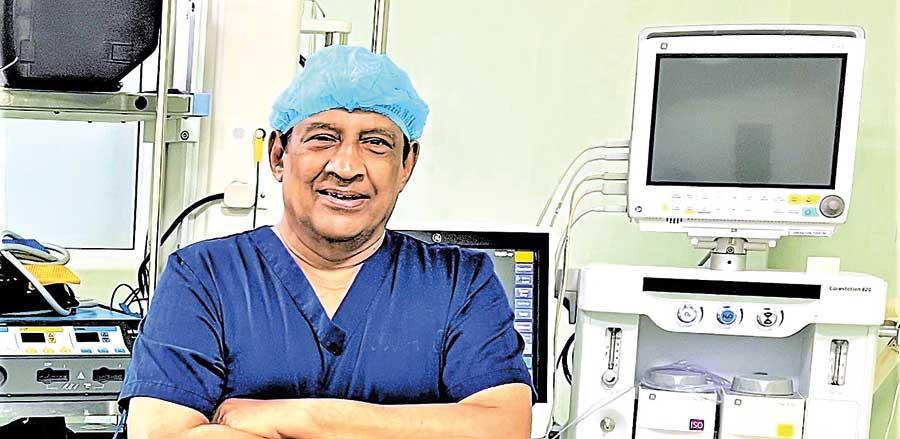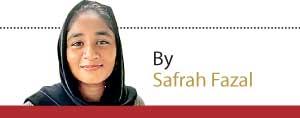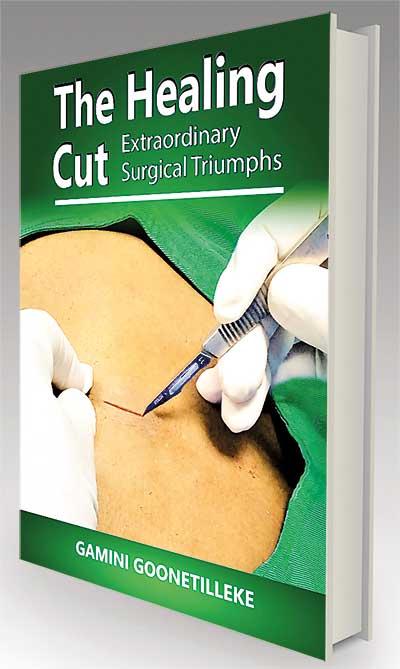14 Feb 2024 - {{hitsCtrl.values.hits}}

Dr. Gamini Goonetilleke
Not every day do we come across doctors who have rendered an extraordinary service to their country and its people. Doctors who have gone beyond the scope of their assigned tasks, showing little concern for their safety, intent on tending to patients under their care is indeed a rare occurrence. Such is the service provided by surgeon Dr. Gamini Goonetilleke.
people. Doctors who have gone beyond the scope of their assigned tasks, showing little concern for their safety, intent on tending to patients under their care is indeed a rare occurrence. Such is the service provided by surgeon Dr. Gamini Goonetilleke.
Polonnaruwa Base Hospital in the early 1980s lacked the most basic facilities required of a surgeon. Dr. Goonetilleke, who had then returned to Sri Lanka after qualifying and training as a Fellow of the Royal College of Surgeons in England (FRCS) following his MBBS from Colombo University, began his surgical practice at this rural hospital. It is the experience that Dr. Goonetilleke garnered at this hospital that led him to accomplish extraordinary feats in his surgical practice. These achievements have transformed the lives of those who underwent his ‘healing cut’.
His latest book, ‘The Healing Cut: Extraordinary Surgical Triumphs’ documents the rare cases Dr. Goonetilleke handled as a surgeon in Sri Lanka.
Daily Mirror sat with Dr. Goonetilleke to discuss his surgical experiences and his latest book, which is set to be launched at the Auditorium of the College of Surgeons of Sri Lanka on February 17 (Saturday).
Excerpts:
His latest book, ‘The Healing Cut: Extraordinary Surgical Triumphs’ documents the rare cases Dr. Goonetilleke handled as a surgeon in Sri Lanka
 Q For those who aren’t familiar with your work, who is Dr. Gamini Goonetilleke?
Q For those who aren’t familiar with your work, who is Dr. Gamini Goonetilleke?
Dr. Gamini Goonetilleke is a surgeon who has been in practice for the past 40 years. I began surgical practice in 1982 as a consultant surgeon at the Polonnaruwa Base Hospital. I was the only surgeon for the entire district with a population of 260,000 for six and a half years. This was an appointment out of my comfort zone, because this hospital had the most basic facilities. I had no junior doctors, anesthetists, or certain equipment required to carry out specific surgeries. But, I stayed there; and with the assistance of the community and international organizations that were carrying out projects in the district, we were able to bring the hospital to a better standard.
Back then, Sri Lankan doctors didn’t want to serve in this hospital. After many complaints to the Ministry of Health, through the World Health Organization (WHO), Burmese doctors were sent to serve at the Polonnaruwa Base Hospital.
through the World Health Organization (WHO), Burmese doctors were sent to serve at the Polonnaruwa Base Hospital.
It was around this time that the civil war broke out in the North and casualties were brought to this hospital for treatment. Because of the war, patients couldn’t be taken to the hospital in the East. This was my first exposure to war casualties; and these were not taught in medical school. So I had to read, learn on the job and teach the junior doctors and staff on the treatment of war injuries.
After my term at Polonnaruwa, I served at the District General Hospital in Gampaha for five and a half years. Then in the 1990s, there was a requirement for surgeons to serve in the North at the battlefront as the Army didn’t have surgeons at the time. So I volunteered at the Army Base Hospital in Palaly, which was then a basic hospital too.
Thereafter, I served at Sri Jayewardenepura General Hospital for 21 years. I retired in 2014 after 32 years in Government service.
Q When you realised that your first station was the Polonnaruwa Base Hospital, wasn’t there any part of you that wanted to request for a transfer or return to England?
That thought didn’t occur to me. I knew that at the end of 3 years in England, I’ll be coming back to serve Sri Lanka. Although there were many jobs available then, I had no wish to serve in England.
The people using the services at the Polonnaruwa hospital were less affluent; they were mainly farmers who had no other place to go. When there was a surgical emergency they had to be transported to Matale or Kandy, which were hundreds of miles away and some died on the way.
I could have given up my post and gone back, but something made me decide on staying in Polonnaruwa.
Q What made you volunteer at the Army Base Hospital in Palaly?
During my initial stint at Polonnaruwa, I was well-experienced at treating war casualties and managing injuries on my own. When I moved to the Gampaha Hospital there was a request from the Army for volunteers. I thought I should make use of my experience to treat the soldiers who were injured.
During his initial stint at Polonnaruwa he was well-experienced at treating war casualties
Q What can you tell about your latest book ‘The Healing Cut’?
I had a habit of documenting my experiences related to my patients. I took photos at the time of admission, during surgery, post surgery and years later. Some of these patients are still in contact with me. When I reflected on these cases, that’s when I began writing these stories on my blog. Then I decided that I should compile these stories into a book– and that’s my latest book ‘The Healing Cut: Extraordinary Surgical Triumphs’. This is a collection of unusual cases that surgeons won’t see in everyday practice. Some aren’t reported in standard textbooks on surgery. This book has over hundred cases of which only about 8 are related to war injuries. The rest are various types of uncommon conditions related to the entire body. It also contains over 350 colour photographs detailing the surgeries.
There was a case of a 14-year-old girl from Monaragala who came to Sri Jayawardenapura General Hospital for treatment that I have documented in this book. She had a habit of eating her own hair. When we performed surgery on her, we found that her stomach was filled with hair and had formed into a hairball. It began from the beginning of the stomach and had gone into her small intestine like a tail and is available for anyone to see at the Auditorium at College of Surgeons of Sri Lanka. I have included a picture of it in the book. This is a famous case of Rapunzel Syndrome.
Q How different is ‘The Healing Cut’ from your previous books?
My first book was ‘In the Line of Duty’, which is an autobiography that was published in 2008. It contains an account of my childhood, my school career, years in Medical College, my training as a doctor and what I did at the Polonnaruwa Base Hospital. It contains few details of my surgical work in Polonnaruwa.
My second book, ‘The Extra Mile’ is mainly about my experiences during the war. It is especially about how I started practising war surgery in Polonnaruwa.
The latest book ‘The Healing Cut’ is a compilation of unusual cases I handled throughout my surgical practice.
Q Is this book for doctors and those in the medical profession?
No, there are many people interested in reading about surgical cases, so I have not used many surgical terms or medical jargon. I have used simple terms that could be understood by anyone. People can also get a better understanding because of the photographs that I have included of patients in different stages of illness, although some might be disturbed when they see these photos.
Q How can people purchase ‘The Healing Cut’?
The book will be launched on February 17 (Saturday) at the Auditorium of the College of Surgeons of Sri Lanka. Those who wish to buy a copy of the book can contact me directly on +94 777 794 107 or email me on: [email protected].
04 Jan 2025 3 hours ago
04 Jan 2025 3 hours ago
04 Jan 2025 5 hours ago
04 Jan 2025 5 hours ago
04 Jan 2025 5 hours ago